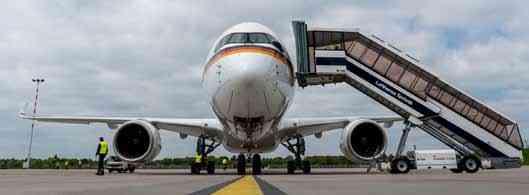
17 minute read
Elbit Awarded Contract for Assemblies for the F-35
Elbit Systems Ltd. announced that its wholly-owned subsidiary, Elbit Systems - Cyclone Ltd., was awarded a contract by Lockheed Martin for the manufacture of assemblies for Forward Equipment Bay assemblies for the F-35. The contract is in an amount that is not material to Elbit Systems and will be performed over a period of four-years.
The contract calls for Elbit Systems to supply assemblies for the F-35’s Forward Equipment Bay – made from composite materials and the associated structures – for all F-35 aircraft variants. Elbit Systems will deliver more than 1,400 components to Lockheed Martin during the contract period. The decision by Lockheed Martin comes as a result of Elbit Systems successful performance on the production of other composite structures for the F-35 program.
Advertisement
This award further expands Elbit Systems work on the F-35, which includes the helmet mounted display systems, the development of the panoramic cockpit display, power amplifiers and 22 different structural assemblies.
Yoram Shmuely, General Manager of Elbit Systems Aerospace Division, said: “We are proud to have been selected by Lockheed Martin to provide additional structural assemblies for the F-35 aircraft. This contract reflects the recognition and trust we have established with Lockheed Martin in our many years of collaborative work”.

Vision Box Implements Automated Gates at Terminal 1 of Kansai International Airport
Vision-Box,Europe’s leading multinational technology company, dedicated to improving the quality and security in government services, travel and border control, has announced the launch of automated pre-security gates at the Kansai International Airport in Osaka, Japan, the second largest airport in the Vinci Group, handling over 30 million passengers annually.
Vision-Box has successfully implemented five banks of 12 pre-security gates (GT11) at Terminal 1 of the Kansai International Airport, operational from Monday, 27 July 2020. The partnership supports Kansai Airports’ wider efforts to promote a ‘Fast Travel’ experience for passengers, allowing for a smoother departure procedure. By automating the boarding pass confirmation procedure at the departure gate, the self-scan will replace the need for inspectors to manually check and scan passenger boarding passes, speeding up the overall travel experience.
The launch of the automated gates comes at a pivotal moment for Kansai International Airport, allowing for fast contactless operation, helping prevent the spread of infectious diseases especially during the current covid-19 pandemic.
Speaking about the launch of the automated gates, Jeremy Goldstrich, COO at Kansai Aiports said: “We are delighted to partner with Vision-Box to implement cutting edge contactless automated gates at Terminal 1, allowing for a seamless travel experience for passengers. By automating the boarding pass confirmation procedure at the departure gate, we will realize a smoother departure procedure. Until now, an inspector took a boarding pass from the customer in front of the international security checkpoint and read it with a scanner to determine whether or not to pass it. Kansai Airports will continue to proactively introduce cutting-edge technology to improve the convenience of the airport and provide a comfortable and new travel experience.”
Speaking about the partnership Miguel Leitmann, CEO of Vision-Box, said: “We are delighted to announce a partnership with Kansai Airports. This is another positive step forward in increasing our presence in the country as we aim to deliver innovate projects which focus on seamless travel and identity management. We believe that the team at Kansai International Airport share our vision to modernise and change the landscape of the travel and aviation industry for the better. While Vision-Box continues to drive such technology in the field, Japan is no doubt one of the leaders in technological development and this partnership is testament to our hard work and expertise in delivering such innovation.”
This latest partnership is another successful milestone for Vision-Box, who have continued to pioneer seamless technology innovations to optimise the flow of travellers both during and after the Covid-19 pandemic. Vision-Box has been at the forefront of contactless automation technology, having installed Europe’s first facial recognition e-Gate at Faro International Airport in 2007. Today, the company’s key partners and customers include the UK Home Office, US CBP, London Gatwick Airport, Eurostar, Air Asia, Emirates, KLM, Dubai Airport, Schiphol Airport, Bangalore International Airport and JFK.
Vision-Box is also working closely with The World Travel & Tourism Council’s (WTTC) and other industry organisations to launch a second phase of measures to rebuild global consumer confidence to encourage the return of travelling, which will focus on safe and efficient solutions to get the travel sector functioning near normal conditions. Vision Box also recently published a focused, highlevel industry survey of the world’s top airports, airlines, and government agencies titled the ‘Effects of COVID-19 pandemic on the aviation sector’, which found 63% of organisations in the aviation, airline sector and government agencies seek to implement biometric technologies at airports for contactless travel.


Ultra secures UK Sonobuoy Test Facility Upgrade contract with QinetiQ
Ultra has secured a contract from QinetiQ to support them in replacing the entire Sonobuoy Test Facility (STF) system at the British Underwater Test & Evaluation Innovations Standard by the Institute of and Knowledge Exchange Innovation (IKE Institute) as a recognition of its good practices and adherence to the newly published ISO 56002 Innovation Management System standard. This rewards an Innovation Management. Creating advantage through innovation by applying a systemic approach, instilling a culture that is proinnovation, embracing an open innovation ecosystem and accelerating promising innovations from idea to solution, quickly and affordably are some of the Centre, MOD BUTEC. This work includes replacing the Software Defined Sonobuoy Receivers (SDSRs), the Command function transmitters as well as a suite of analysis software for the recommended practices that MBDA has been recognised for, when it successfully achieved the Accreditation.
Eric Béranger, CEO of MBDA commented on achieving this combined recognition: “Innovation is one of our 5 corporate values. We bet on innovation because it is central to our future growth and competitiveness, allows to reduce costs and waste, and increases productivity and resource efficiency, ensuring in the end our customers’ satisfaction and improving sustainability and resilience for the company. To grab the full benefits of innovation, MBDA has put in place organisations and processes that span over its five home nations in Europe, engaging our engineers to share knowledge, experience Ground Monitoring Station which provides control, monitoring, recording and analysis capabilities for the Sonobuoy on test.
New capabilities, which include user friendly graphics and the reuse of seabed hardware to replace surface test equipment, will offer a real saving to the customer. Not having to deploy equipment manually from a small boat means the new system will be safer and less time consuming to use.
QinetiQ and Ultra will collaborate to deliver the STF requirements with and best practices fitting with our vision of creating the world’s best complex weapons that deliver the required proportionate military effects. I take the IKE Institute’s ISO 56002 accreditation as a strong recognition of the commitment and efforts of all our employees, partners and stakeholders who have made this achievement possible, particularly in the current circumstances of COVID-19.”
Professor Sa’ad Sam Medhat, IKE Institute Chief Executive and member of the BSI/ ISO Innovation Standards Committee said: “MBDA continues to surprise us with their unwavering efforts to push the innovation envelope to the next stage, and have demonstrated best practice in a number of benchmarking categories. QinetiQ providing the COTS computer equipment including networking, data storage and installation.
For over 70 years Ultra has supplied world-leading sonobuoys, sonobuoy receivers and sonobuoy command transmitters to navies worldwide for airborne AntiSubmarine Warfare (ASW). Sonobuoys are deployed onto the sea surface and used for detection, classification and localisation of submarines. Test and training for UK sonobuoys is undertaken at the STF at MOD BUTEC
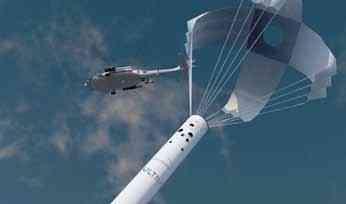
MBDA Gets International Recognition for its Management of Innovation
MBDA has been accredited as Investor in
in North West Scotland. MBDA’s Innovation Policy and its consistent execution within the teams spread across many countries including France, Italy, Germany and the UK, demonstrates a systematic approach to innovation capability development that delivers value to everyone involved. This rigorous review and robust analysis by the Validation Panel of c-suite executives drawn from the Innovation Council, provided a thorough action plan for crystallising innovation further within MBDA’s strategic mission. I believe, MBDA is the first multinational company that has embraced and implemented the international innovation guidelines as set out by the ISO 56002 standard. So, may I congratulate MBDA on this excellent achievement.”
Schiebel, together with partners Nordic Unmanned and the NORCE Research Institute AS, is operating the CAMCOPTER® S-100 to monitor ship emissions for French Maritime Authorities.
The service providers for this French deployment cover ship sulphur emission monitoring in one of the world’s busiest shipping lanes in the strait of Pas-de-Calais. The operation started on 23 September and will run for three months. The Unmanned Air System (UAS) CAMCOPTER® S-100 specifically measures the ships’ sulphur emissions to check compliance with the EU rules governing the sulphur content of marine fuels. Measurements are transmitted in real time through the EMSA RPAS Data Centre to the relevant authorities.
The Remotely Piloted Aircraft System (RPAS) service is offered by the European Maritime Safety Agency (EMSA). As part of this contract, Schiebel provides various maritime surveillance services for EMSA to several EU member states and EU bodies. Currently, the CAMCOPTER® S-100 is also operational in Denmark for emission monitoring purposes, as well as in Finland supporting coast guard functions. In addition to the EMSA contract, the S-100 is being operated by the French Navy to conduct maritime surveillance. The S-100 has a flight endurance of more than six hours and operates
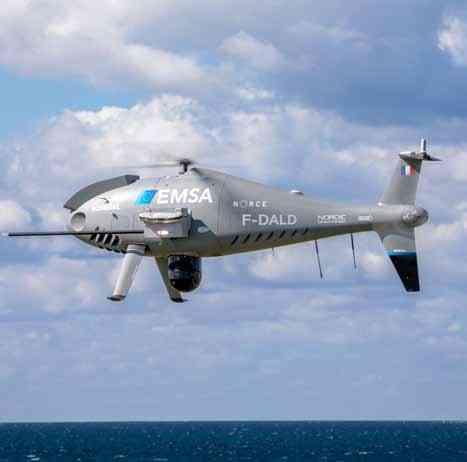
Raman R is GM (Internal Audit) at BEL
Raman R took charge as General Manager (Internal Audit) of Navratna Defence PSU Bharat Electronics Limited (BEL). He was Additional General Manager (Internal Audit) at BEL-Corporate Office prior to his elevation.
A postgraduate in Commerce and Fellow Member of the Institute of Chartered Accountants of India, Raman joined BEL on July 17, 1989, as Accounts Officer. He started his career, making significant contributions in almost all areas of Finance & Accounts working at BEL’s Corporate Office and International Marketing Division.
In August 2010, he was transferred to BEL’s Bangalore Complex, where he worked for about a decade, in various capacities and in many Strategic Business Units (SBUs) such as Military Communications (Milcom), Naval Systems (Radar & Fire Control Systems), Missile Systems and Central Finance.
Raman has spearheaded the formulation of BEL Executives’ Pension Scheme and was instrumental in BEL bagging its first national award from ICWAI, New Delhi, for “Cost Management” during FY 2005-06.
day and night. It is equipped with an Explicit mini sniffer sensor system, an Electro-Optical / Infra-Red (EO/ IR) camera gimbal and an Automatic Identification System (AIS) receiver.
Hans Georg Schiebel, Chairman of the Schiebel Group, said: “Due to its multi-payload capacity, the applications for the S-100 are limitless. The sulphur sniffing capability is one of the latest innovations and we are very proud to play such an important role in enforcing marine fuel sulphur content regulations.”
Virgin Galactic Unveils Mach 3 Aircraft Design, Signs MOU with Rolls-Royce

Company Announces Completion of Mission Concept Review Program Milestone.
Virgin Galactic Holdings, Inc., a vertically integrated aerospace and space travel company, which includes its manufacturer of advanced air and space vehicles, The Spaceship Company (“TSC”), announced the first stage design scope for the build of its high speed aircraft design, and the signing of a non-binding Memorandum of Understanding (MOU) with RollsRoyce to collaborate in designing and developing engine propulsion technology for high speed commercial aircraft. This follows the successful completion of its Mission Concept Review (“MCR”) program milestone and authorization from the Federal Aviation Administration’s (“FAA”) Center for Emerging Concepts and Innovation to work with Virgin Galactic to outline a certification framework. This marks an exciting step forward in Virgin Galactic’s development of a new generation of high-speed aircraft, in partnership with industry and government leaders, with a focus on customer experience and environmental sustainability.
Rolls-Royce is a leader in the cuttingedge technologies that deliver clean, safe, and competitive solutions to the planet’s vital power needs. Rolls-Royce has a proven record of delivering high Mach propulsion, powering the only civil-certified commercial aircraft (Concorde) capable of supersonic flight.
George Whitesides, Chief Space Officer, Virgin Galactic said, “We are excited to complete the Mission Concept Review and unveil this initial design concept of a high speed aircraft, which we envision as blending safe and reliable commercial travel with an unrivalled customer experience. We are pleased to collaborate with the
innovative team at Rolls-Royce as we strive to develop sustainable, cuttingedge propulsion systems for the aircraft, and we are pleased to be working with the FAA to ensure our designs can make a practical impact from the start. We have made great progress so far, and we look forward to opening up a new frontier in high speed travel.”
“We are excited to partner with Virgin Galactic and TSC to explore the future of sustainable highspeed flight,” said Rolls-Royce North America Chairman & CEO Tom Bell. “Rolls-Royce brings a unique history in high speed propulsion, going back to the Concorde, and offers worldclass technical capabilities to develop and field the advanced propulsion systems needed to power commercially available high-Mach travel.”
The Mission Concept Review, which included representatives from NASA, is an important program milestone at which the Virgin Galactic high speed team confirmed that, based on the research and analysis work completed, its design concept can meet the highlevel requirements and objectives of the
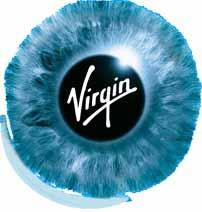
Schiebel, Nordic Unmanned Demonstrated Cargo Delivery Capability of CAMCOPTER® S-100
This is world’s first in terms of full-scale offshore UAV delivery from shore to an active oil and gas installation. The exercise simulated the scenario of an urgent requirement for specific essential spare parts at the gas production platform Troll A. The CAMCOPTER® S-100 successfully carried out the long-range delivery flight from Mongstad, where the spare parts were 3D-printed, to the offshore platform Troll A located in the North Sea.
The unmanned delivery distance mission. Previously, NASA signed a Space Act Agreement with Virgin Galactic to collaborate on high speed technologies.
The basic parameters of the initial high speed aircraft design include a targeted Mach 3 certified delta-wing aircraft that would have capacity for 9 to 19 people at an altitude above 60,000 feet and would also be able to incorporate custom cabin layouts to address customer needs, including Business or First Class seating arrangements. The aircraft design also aims to help lead the way toward use of state-of-the-art sustainable aviation fuel. Baselining sustainable technologies and techniques into the aircraft design early on is expected to also act as a catalyst to adoption in the rest of the aviation community.
The MCR concluded that the team was 100 km (55 nm). After the UAV supplied the spare parts, it carried out a close inspection around the platform before it headed back to Mongstad. The flight trials also included a successful Search and Rescue (SAR) mission, where a “man over board” dummy was quickly located by the UAV, transmitting the positioning data and live images using the L3 Harris Wescam real-time Electro-Optical/ Infra-Red (EO/IR) camera and an Automatic Identification System (AIS). can progress to the next phase of design, consisting of defining specific system architectures and configurations, and determining which materials to use in the design and manufacturing of the aircraft. The team will also work to address key challenges in thermal management, maintenance, noise, emissions, and economics that routine high speed commercial flights would entail.
The design philosophy of the aircraft is geared around making high speed travel practical, sustainable, safe, and reliable, while making customer experience a top priority. Virgin Galactic is designing the aircraft for a range of operational scenarios, including service for passengers on long-distance commercial aviation routes. The aircraft would take off and land like any other passenger Schiebel, together with partner Nordic Unmanned, successfully demonstrated the cargo delivery capability of its Unmanned Aerial Vehicle (UAV) CAMCOPTER® S-100 to offshore platform Troll A to Norwegian energy company Equinor.
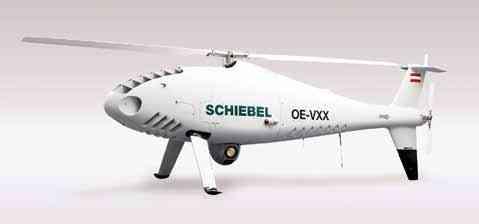
Hans Georg Schiebel, Chairman of the Schiebel Group, said: “This was the perfect trial to show off the exceptional maritime capabilities of the S-100 for the oil and gas industry. We have extensive experience in long-range unmanned flights, especially in the maritime domain and under adverse weather conditions. The S-100 was able to show off its outstanding capabilities and we have proven once again that the
S-100 UAV is the superior choice.” aircraft and be expected to integrate into existing airport infrastructure and international airspace around the world.
Virgin Galactic is working closely with international regulatory communities to ensure compliance with safety and environmental standards. Last week the FAA’s Center for Emerging Concepts and Innovation reviewed the project direction and authorized FAA resources to work with the Virgin Galactic team to begin to outline a certification framework during the pre-project guidance phase. Virgin Galactic believes that working together with regulators and industry leaders such as Rolls Royce and Boeing will support the mission to broaden and transform global travel technologies, with a focus on customer experience.
Lufthansa handed over the New Airbus A350-900s German Government’s Special Air Mission Wing
Lufthansa Technik AG handed over the first of three new Airbus A350-900s to the German Armed Forces. During a ceremony in Hamburg, conducted according to current pandemic rules, Minister of Defence Annegret Kramp-Karrenbauer took a first look at the future flagship of the Federal Ministry of Defence’s (BMVg) Special Air Mission Wing. On the way to the final operational readiness of the aircraft, the military certification for the 10+03 designation and various test flights with the new widebody aircraft will take place in the coming weeks. This is the world’s first government aircraft of this type and thus also the world’s first Airbus A350 not to be used in commercial airline service.
“The exemplary procurement process is really something to be proud of,” said Minister KrampKarrenbauer. “The decision to purchase the new A350 fleet was made just 1.5 years ago. My thanks therefore go to all those involved in industry and German Armed

Forces, because everyone really pulled together here. With its 25 percent lower fuel consumption - compared to older, comparable types - the ultra-modern A350 is future-oriented, and with the new fleet we are securing global mobility as an important part of the Federal Government’s ability to work”, the Federal Minister continued. “And with the addition of two more brandnew A350s, the mobility expected of an industrial nation like Germany is adequately ensured.”
“Today we are proud to present to the Federal Minister of Defence the new lagship of the Federal Government’s Special Air Mission Wing, the world’s very first Airbus A350 as a government aircraft,” said Dr. Johannes Bussmann, Chairman of the Executive Board of Lufthansa Technik AG. “The 10+03 and its two subsequent sister aircraft are a continuation of the successful tradition of supplying the German Armed Forces and having them as one of our best and most important customers.”
The factory-fresh aircraft, which was still on the civil register as D-AGAF, arrived at Lufthansa Technik at the beginning of May. It is equipped with a special transitional cabin for political-parliamentary flight operations. The cabin comes with office and conference areas, adjoined by a multifunctional lounge area. The remaining space is available for delegations flying on the aircraft. After sister aircraft 10+01 and 10+02, which are currently under construction, will

receive a fully-fledged government cabin from Lufthansa Technik next year, the transitional cabin in the 10+03 will also be exchanged.
The effects of the global coronavirus pandemic on the supply chain slightly delayed the planned delivery of the 10+03 to the German Armed Forces. It will now take place in the coming weeks, during which the aircraft will receive its military certification and be prepared for a smooth entry-into-service at the Federal Ministry of Defence’s pecial Air Mission Wing, complete with crew training and various test flights.
